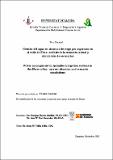Por favor, use este identificador para citar o enlazar a este item:
http://hdl.handle.net/10261/4810COMPARTIR / EXPORTAR:
 SHARE
BASE SHARE
BASE
|
|
| Visualizar otros formatos: MARC | Dublin Core | RDF | ORE | MODS | METS | DIDL | DATACITE | |

| Título: | Gestión del agua en sistemas de riego por aspersión en el valle de Ebro: análisis de la situación actual y simulación de escenarios |
Otros títulos: | Water management in sprinkler irrigation systems in the Ebro valley: current situation and scenario simulations | Autor: | Dechmi, Farida CSIC ORCID | Director: | Playán Jubillar, Enrique CSIC ORCID; Faci González, José María | Fecha de publicación: | 2003 | Editor: | Universidad de Lleida | Citación: | Tesis doctorales EEAD | Serie: | TD-2003-1 | Resumen: | In all irrigation systems, adequate irrigation design and management are required to promote an efficient use of available water, increase crop production and minimise deep percolation losses. In this research, a contribution to water conservation in sprinkler irrigation systems was performed. An analysis of water use and irrigation performance in the Loma de Quinto District (LQD) is presented. This district is located in the Ebro valley (NE Spain), and irrigates 2,606 ha with a wide variety of sprinkler irrigation systems. This analysis represents a contribution to the Diagnostic Analysis phase of an incipient Management Improvement Program for the LQD. In Chapter I, the irrigation management problems at the LQD and the factors affecting local water management were analysed. The high cost of irrigation water in relation to crop revenues, the technical deficiencies of the irrigation systems, and the limitations imposed by the climate and soils appear to be major causes of the water management problems identified in the LQD. In chapter II, the analysis of irrigation water use focused on two additional issues: irrigation uniformity and the relationship between water use and crop yield. The results of the irrigation evaluations indicated that the solid-set Christiansen Coefficient of Uniformity (CU) was severely reduced by wind speed. However, in centre-pivots and linear-moves CU was slightly higher in evaluations with wind speeds between 2 and 6 m s-1 than under calm conditions. The evaluation data set was used to validate a ballistic solid-set sprinkler irrigation simulation model. The model was used to extend the evaluation results to all the solid-set plots in the LQD. Simulations of irrigation scheduling performed on a limited number of plots detected a 12 % decrease in crop yield due to deficit irrigation and/or large irrigation intervals. The introduction of an optimal irrigation schedule (avoiding yield reductions) would imply increasing the alfalfa seasonal irrigation depth by 101 mm, and applying light, frequent irrigation events. A field experiment was performed to study the effect of the space and time variability of water application on solid set sprinkler irrigated corn yield (Chapter III). A solid-set sprinkler irrigation setup typical of the new irrigation developments in the Ebro basin of Spain was considered. The results of this research showed that large percentages of the CU variability and the wind drift and evaporation losses were explained by the wind speed alone. No evidence was found proving that the soil diminishes the heterogeneity induced by the irrigation water distribution. Results indicated that grain yield variability was largely dictated by the water deficit resulting from the non-uniformity of water distribution during the crop season. The irrigation depth resulting from irrigation events applied beyond the flowering stage was significantly correlated with grain yield. The development of a coupled crop model (Ador-Crop) and solid set sprinkler irrigation model (Ador-Sprinkler) is presented in Chapter IV. Ador-Crop incorporates many of the features developed in the well-known CropWat model. Relevant improvements include the use of thermal time and the input of daily potential evapotranspiration. Ador-Sprinkler applies ballistic theory to determine water distribution resulting from sprinklers subjected to a wind vector. The model was calibrated with field experiments performed in two adjacent plots on a corn crop irrigated with sprinklers equipped with 4.4 and 2.4 mm nozzles in a triangular spacing of 18 x 15 m. Once the calibration phase was completed, Ador-Sprinkler adequately predicted irrigation water distribution during the whole corn development cycle. The crop model was validated through a comparison with CropWat. Both models produced similar yield reduction results. Regarding the coupled model validation, the plot of soil available water vs. measured and simulated yield reduction resulted in similar features. The coupled model explained 25 %** of the variability in measured yield reduction. The model was exploratorily applied to a number of design and management issues in solid-set irrigation (Chapter V). The most relevant results are related to the characterization of advanced irrigation scheduling strategies. The differences in crop yield and water use derived from conducting irrigations at different times of the day were estimated for two locations strongly differing in wind speed. Irrigation guidelines were established in these locations to relate gross water use and water stress induced yield reductions. Simulations were also applied to estimate the value of wind speed thresholds for irrigation operation. In the windy location, a threshold of 2.5 m s-1 resulted adequate to control yield reductions and to minimize water use. |
Descripción: | Tesis defendida en dic. 2002. | URI: | http://hdl.handle.net/10261/4810 |
| Aparece en las colecciones: | (EEAD) Tesis |
Ficheros en este ítem:
| Fichero | Descripción | Tamaño | Formato | |
|---|---|---|---|---|
| 2002-TesisFaridaDechmi.pdf | 4,45 MB | Adobe PDF |  Visualizar/Abrir |
CORE Recommender
Page view(s)
482
checked on 19-abr-2024
Download(s)
580
checked on 19-abr-2024
Google ScholarTM
Check
NOTA: Los ítems de Digital.CSIC están protegidos por copyright, con todos los derechos reservados, a menos que se indique lo contrario.
